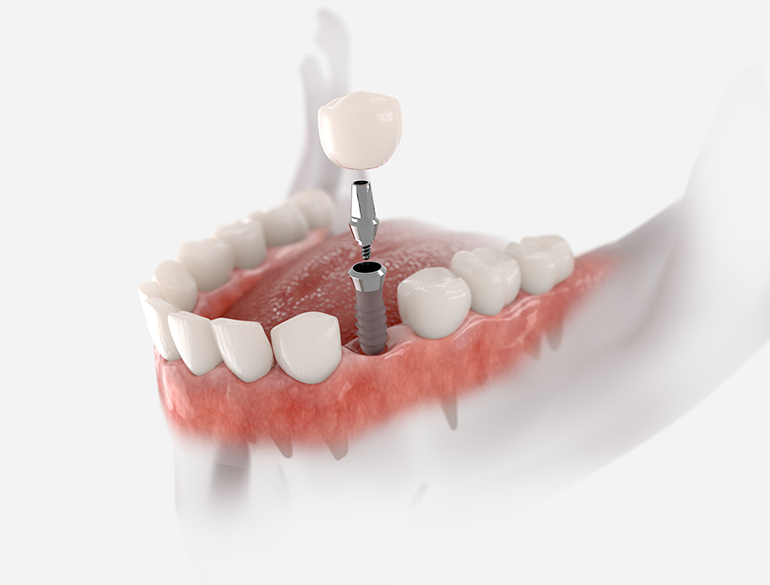The Best Guide To Dental Sense
The Best Guide To Dental Sense
Blog Article
How Dental Sense can Save You Time, Stress, and Money.
Table of ContentsThe Only Guide to Dental SenseHow Dental Sense can Save You Time, Stress, and Money.An Unbiased View of Dental SenseRumored Buzz on Dental Sense
are clinical gadgets surgically dental implanted right into the jaw to recover a person's capability to chew or their appearance. They offer assistance for synthetic (phony) teeth, such as crowns, bridges, or dentures. When a tooth is lost due to injury or disease, an individual can experience complications such as fast bone loss, faulty speech, or adjustments to chewing patterns that lead to discomfort.Oral implant systems contain a dental implant body and dental implant joint and might likewise include an abutment fixation screw. Wisdom tooth cavity. The oral implant body is operatively placed in the jawbone in area of the tooth's origin. The oral implant abutment is generally attached to the dental implant body by the joint fixation screw and extends via gums into the mouth to sustain the connected artificial teeth
(https://linktr.ee/dentalsense1)Structure of The Dental Implant System choosing oral implants, speak with your dental provider regarding the possible advantages and risks, and whether you are a candidate for the treatment. Things to take into consideration: Your general wellness is an essential consider establishing whether you are a good candidate for oral implants, the length of time it will take to heal, and how much time the implant may stay in place.
Cigarette smoking may affect the healing process and reduce the long-term success of the implant. The recovery procedure for the dental implant body may take several months or longer, during which time you normally have a temporary joint in area of the tooth. the dental implant treatment: Meticulously comply with the oral health guidelines provided to you by your dental provider.
Unknown Facts About Dental Sense
Implant failure can cause the need for an additional procedure to fix or replace the dental implant system. Restores the capacity to eat Brings back cosmetic look Assists keep the jawbone from diminishing due to bone loss Protects the health of the bordering bone and gums Helps maintain nearby (close-by) teeth stable Improves lifestyle Damages to bordering natural teeth during dental implant placement Injury to the surrounding cells throughout surgery, such as sinus opening Injury throughout surgical treatment (for instance, fracture of bordering jawbone) Insufficient feature, such as feeling like the teeth do not bite together usually A sensation that the tooth is loosened or twisting in position resulting from a joint screw loosening Implant body failing (looseness of the implant body) as a result of systemic infection, which might be more probable in people with unchecked diabetes because of local infection in bone and periodontals sustaining the implant body because of postponed healing, which might be more probable in individuals who smoke Trouble cleaning up the periodontals around the implant, resulting in bad oral health Without treatment gum illness Post-surgical feeling numb as a result of nerve impingement or damages Constantly notify healthcare companies and imaging professionals that you have oral implants prior to any magnetic resonance imaging (MRI) or x-ray procedures.
FDA is not knowledgeable about any type of adverse events reported for MRI or x-ray procedures with dental implants. Oral implants systems are typically made from products that follow international consensus requirements of the International Company for Standardization (ISO) or ASTM International. These requirements have information of what makes a secure product.

A dental implant is a framework that changes a missing out on tooth. With screw-like gadgets, the cosmetic surgeon inserts a dental implant into the jawbone, and it acts as an anchor for an artificial tooth, called a crown.
Little Known Questions About Dental Sense.
Some people are not eligible for dental implant surgery. It is for dental doctors to operate individuals with: acute illnessuncontrollable metabolic diseasebone or soft tissue condition or infectionIf these concerns are solved, a person can have the surgical procedure. In, oral surgeons avoid operating on individuals with: If individuals with any one of the above undertake oral implant surgical procedure, there is a greater risk of the dental implant falling short.

Oral implant surgical procedure is a tailored procedure. It's not the exact look here same for every person. The adhering to offers a general overview of what you can expect your dentist, oral cosmetic surgeon, periodontist or prosthodontist to do: Position the implant operatively. Offer you time to recover. Affix the post and final crown, bridge or denture.
Next off, your specialist will carefully put the oral implant right into your jaw. Ultimately, your specialist will reposition your gum tissues and shut the laceration with stitches. If your implant is near the front of your mouth, your dental expert will make a temporary tooth for you to put on up until you recover. In this way, you will not have a void in your smile while you recuperate.
The smart Trick of Dental Sense That Nobody is Talking About
During the healing stage, your jawbone ought to fuse to the dental implant. This procedure can take anywhere from three to nine months.
When your implant heals, your dentist can affix the abutment (tiny port post) and your final repair (crown, bridge or denture). This usually takes concerning one hour to complete and might need a 2nd small surgical procedure. You should not feel any type of discomfort during your oral implant treatment since your copyright will certainly utilize medicine to numb your gums.
Report this page